How To Sell Photos Online In 2024 (Beginners Guide)

Want to learn how to sell photos online? We’ve got you covered.
If you’re a talented photographer, you could make a ton of money selling your snaps as stock photos and digital prints. And in this post, we’re going to show you how.
First, we’ll look at how to take awesome photos and get them ready for sale. Then, we’ll show you how to list them for sale on your own website and on popular third-party marketplaces.
And if you stick around until the end, we’ll also be sharing some powerful marketing strategies that you can use to get more customers.
Why sell photos online?
First, let’s look at some of the main reasons why you’d want to sell photos online in the first place:
- Passive income. The best thing about selling photos online is that, unlike selling photography services, it’s a totally passive income stream. You only have to take a photo once and you can sell it over and over again under a non-exclusive license for a lifetime of income.
- Easy fulfillment. Photos can be sold online as digital downloads, which makes fulfillment super simple. You don’t have to print, frame, and ship your photos to your customers—you can just take payment and email them a download link instantly.
- Hone your skills. Selling photos online gives you a reason to experiment with taking different kinds of shots. You’ll be practicing your photography skills and making money at the same time.
- Few start-up costs. Unlike other types of businesses, it costs almost nothing to start selling photos online. Other than a small monthly subscription fee for website hosting, all you need to invest is your time.
- High demand. Photos are one of the most in-demand types of digital products. There are tons of businesses out there willing to pay for high-quality stock photos, and even more consumers looking for aesthetic photography prints.
How to take photos that sell
Next, we’re going to share some tips on how to actually take photographs that are more likely to sell well online.
But if you’ve already shot your photos and just want to know where to sell them, feel free to skip this part.
Get the right equipment
iPhone cameras might be sufficient for hobbyists and amateurs, but it’s not going to cut it if you want to sell photos online.
For that, you’re going to need to invest in some real gear.
DSLRs are usually the best choice when it comes to photography cameras. They offer a wider range of interchangeable lenses and attachments, have superior battery life, great low-light shooting, and are generally capable of producing better, higher-resolution images.
The Nikon D850 is a great option. But ultimately, it’s up to you—choose whatever camera you think makes the most sense for the kind of photos you want to shoot and your budget.
Aside from the camera body itself, you’ll of course also need a lens kit. Explaining the intricacies of choosing lenses is outside the scope of this article, so you might want to research that on your own time. But the most important factor to consider is focal length.
Most professional photographers have a bunch of different lenses that they’ll switch between depending on what they’re shooting. But if you want to start out with just one, we’d recommend a 50mm normal lens. They’re affordable, lightweight, and optically excellent.
As you take shots with a 50mm lens, you’ll learn more about what your needs are and may want to purchase additional lenses—but a 50mm is a great starting point.
There are a few other pieces of equipment you might want in your photography kit besides from the above, such as:
- Filters
- A tripod
- A lighting kit
- Studio backdrop
- External flash
Again, we don’t have time to cover all of the above in this guide. Just make sure you have everything you need before you start shooting.
Choose your niche
The next step is to choose your niche.
All successful photographers tend to cater to a specific target market and typically have a consistent theme that runs across all their photos. This is their niche.
Some examples of photography niches include:
- Wildlife photography
- Action sports photography
- Astrophotography
- Portrait photography
- Travel landscape photography
- Food photography
You get the idea.
To choose your niche, start by asking yourself what kind of photos you like to take. Then, do some research to make sure there’s a market demand for those types of photos, and that there’s sufficiently low competition that you stand a chance of making sales.
Keyword research tools can help with this step in the process. They can tell you how many people search the internet for different types of photos, which can help you to get an idea of whether or not there’s demand for it.
For example, according to Keyword Surfer, 1,000 people search for ‘office stock photos’ every month in the US alone.

If that many search for office stock photos on Google alone in the US, then thousands more probably search for it directly on stock photo sites, and from other countries around the world. So we can be pretty certain it’s in high demand.
You can also try experimenting with keywords that include subjects or locations (e.g. ‘photos of the Milkyway’, ‘photos of New York’, etc.) to find in-demand niches. Or just check popular stock photo sites to see what the best-selling categories are.
Learn the ropes
If you’re already a professional photographer who knows their way around a DSLR, then great.
But if you’re an amateur and you want to start selling photos online, you’ll need to actually learn how to take great photos first.
We can’t teach you that in one article. So instead, you might want to take a digital crash course on photography to learn the ropes.

There are plenty of courses on online marketplaces like Udemy that can teach you the basics. And there are even courses for specific niches.
For example, here’s a course specifically for learning night photography. And here’s another for commercial food photography.
Start shooting
Now, this is the fun part. Time to go out and start shooting photos.
How you go about this part is completely up to you. But there are a couple of important things to keep in mind.
First off, if you’re including people, keep in mind that anyone featured in your photos may need to sign a model release form before you can sell them. Stock libraries often have model release forms that you can download and use.
Secondly, bear in mind that you might not be able to sell photos that include trademarked brands, products, buildings, etc.
Also, I’m not a lawyer, so don’t consider any of this legal advice. Do your own research and make sure you know all the relevant laws and regulations to ensure you’re fully compliant before you start selling.
Edit your photos
Once you’ve taken the photos you want to sell, the last step is to polish them up in photo-editing software.
Most photographers use apps like Adobe Lightroom and Photoshop for this. You might want to adjust things like exposure, clarity, contrast, vibrance, and temperature to make sure it looks exactly the way you want it to.
Depending on where you plan on selling your photos, you may also want to apply a watermark in Photoshop to prevent people from stealing them from your website. However, if you’re going to be listing on marketplaces, you can probably skip that part as they’ll usually take care of watermarking for you.
Bonus tip: You can also upsell the Lightroom presets you use for edits alongside your photos in your store. Check out our guide on how to make and sell Lightroom presets to learn more.
How to sell photos online on your website
The best place to sell photos online is through your own website. Here’s why.
First off, selling photos through your own site means you can charge more per sale than you’d typically earn on stock photography sites.
On stock photo sites, you’ll typically earn a measly $0.25 – $0.50 per sale. But when you sell exclusive licenses for photos on a site you own, you can earn $50 – $500 or more per sale. And there’s no middleman so you get to keep 100% of your profits.
Plus, selling through your own photography site is much better from a branding perspective. Your online store can double up as your photography portfolio and help to bring in more exposure.
And of course, you have much more flexibility when you sell on your own site compared to third-party marketplaces.
You have full control over your checkout, store design, prices, license terms, etc. Plus, you can sell whatever products you want. Not just digital photos, but also photography services, prints
And the best part is it’s easy to build your own website thanks to Sellfy. You can be up and running in under an hour. Here’s how to get started.
Step 1: Sign up for Sellfy.
Sellfy is an ecommerce platform that’s perfect for selling digital products like photos. It’s easy to use, affordable, and doesn’t charge any transaction fees.
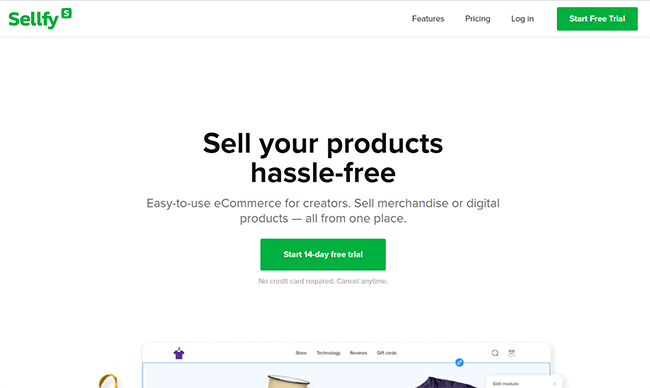
To get started, head to Sellfy’s pricing page and choose your plan. You can get started with a free 14-day trial (no credit card required) so you can test it out before you get locked into a monthly subscription and make sure it’s a good fit for your needs.
After signing up, you’ll be brought to your dashboard, where you can start building your store.
Step 2: Upload photos to your store
Once you’ve reached the dashboard, the next step is to add your products.
If you want to sell your photos as digital images, click Product > Digital product > Add new product. Then, upload your first photo or photo bundle.

You’ll need to enter a name for the product and a description. Plus, you’ll need to set your pricing.
Think carefully about what sort of license you want to sell your photos under, and factor this into the price. The main thing to consider is whether you want to sell your photos exclusively or non-exclusively.
With the former, you’ll only be able to sell your photo once as you’ll be granting the buyer exclusive rights to use it, but you can charge big bucks for the privilege.
With the latter, you can sell your photo again and again to many different customers, but non-exclusive licenses typically are a lot cheaper, so you won’t make as much per sale.
Once you’ve finished filling everything out, click Save product to launch the product page on your new Sellfy site.
Bonus tip: Aside from selling photos as digital products, you can also use Sellfy’s built-in print-on-demand (POD) feature to sell them as physical prints on different products.
Step 3: Finish setting up your store
Finally, you can head to the Store settings page to finish setting up your store.
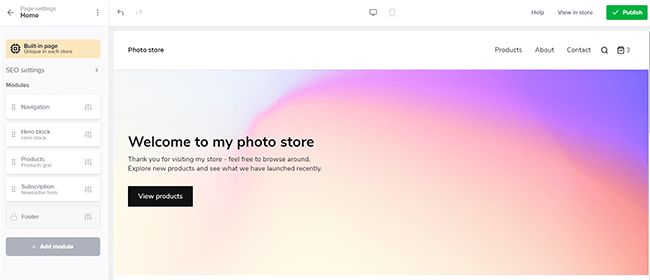
You’ll need to connect a payment processor so you can start accepting payments (i.e. Stripe or PayPal) and set up your custom domain.
You can also customize the design of your store by changing the theme and editing the layout in the Store Customizer. It has a drag-and-drop interface so it’s super easy to use.
Once you’ve done all that, you should be ready to launch.
How to sell photos online through marketplaces
If you don’t think that creating your own photo website is the right choice, then the next best option is selling your images on marketplaces and stock photography websites.
The benefits of selling on a marketplace are that it increases the discoverability of your photos. You don’t need to worry too much about marketing your images, as potential customers will be able to find them using the marketplace search function.
However, selling on marketplaces also has its downsides, mainly when it comes to profit margins. Most marketplaces will take a cut of the profits, some significantly higher than others. Below are some of the best photo marketplaces to list your snaps on.
Photodune
Best for selling stock images
Photodune is a well-known site for selling royalty-free stock images.
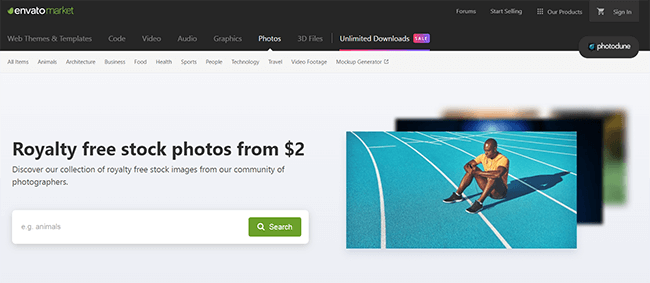
The stock photography website is a part of the online creative brand Envato, and it has a wide user base of marketers, designers, and developers, who are usually willing to pay more than the average consumer for the stock images they use.
Fees on Photodune vary from 12.5% to as much as 55%. If you sign up as an exclusive author, then your fees will be capped at 37.5%. Customers have the option of purchasing regular or extended licenses for photos. Regular licenses start from $5 and extended licenses cost between $50 and $100.
Although the fees seem quite high on Photodune, they are lower than some competing platforms, and it’s one of the best platforms for discoverability. However, it’s also pretty competitive.
Etsy
Best for profit margins
Etsy is most commonly known as a site for selling homemade or handmade products. But in recent years, it’s also become a hub for selling digital products, including photos.
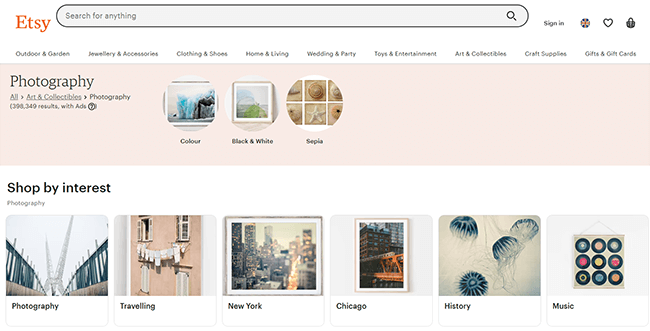
Although it’s not a typical stock photo site, it can be a really good place to sell your photos in digital or physical formats. With Etsy, you can list up to 40 products for free, and you’ll only be charged a 6.5% fee on any sales you make.
In comparison to stock image marketplaces, this is extremely low, and you have the freedom to set your prices as high or as low as you see fit. It’s also easy to link up other tools such as print on demand services.
Etsy has a large but very clearly-defined audience, with over 80% of users being young women in their 20s and 30s. So this is something to consider when deciding whether Etsy is the right place for your work.
However, if your photography style is well suited to this target audience, then it could be a great alternative to some of the more generic photo marketplaces available.
Wunderpics
Best for event photographers
Wunderpics is another photo marketplace that offers a unique opportunity for event photographers.
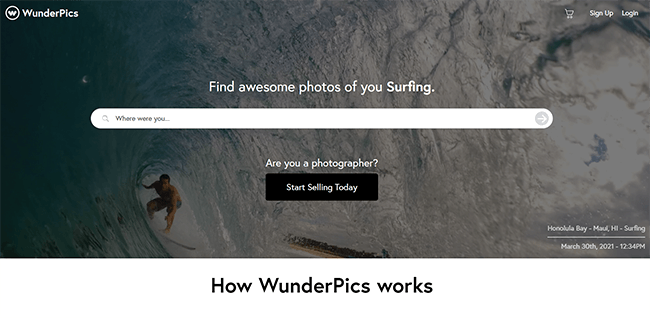
Here’s how it works. First, photographers go out and photograph action sporting events or activities and then list them on Wunderpics. Then, they tag them with the location, date, and time of the event.
The people who attended the event such as athletes, performers, or passersby can then search Wunderpics to find professional photos of themselves. And they can purchase photos they like to use on their own websites or social media.
What’s great about this site is that photographers can set the price of their own photos, and Wunderpics will take a relatively small 15% commission from each sale. You can also upload 15GB of photos for free, but after that, you’ll need to upgrade to a paid plan.
Wunderpics offers a revolutionary new way for event, street, and sports photographers to sell their photos that is convenient for both the creator and the seller.
Getty Images
Best for higher priced photos
Getty Images is a community marketplace that is aimed at high-end clients. As such, photographers can sell their photo licenses for higher prices than they would be able to on microstock sites. It’s also a good place to find long-term clients that you can build a lasting relationship with.
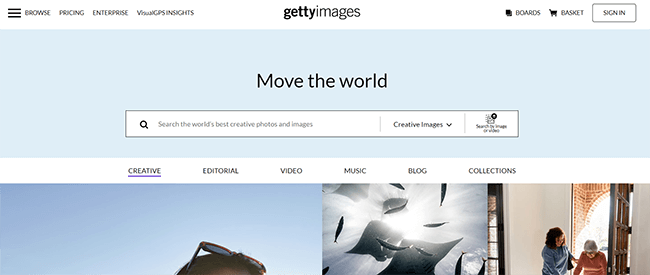
However, this greatly increases the competition on this platform, so it’s important that your images are top quality if you want to make sales on this website.
What’s interesting about Getty is that you don’t just have to sell photos, you can also use it to sell illustrations and videos, which is great if you’re looking to diversify your income stream.
Getty is free to sign up for, but you do have to have your images approved by the Getty team in order to start selling on the platform.
Although Getty is a good platform for selling your photos at a higher price, the commissions are also a little on the high side too. You can expect to be charged between 20% and 45% on every image you sell.
500px
Best paid option
500px is a photo marketplace that takes a slightly different approach to fees and commissions.
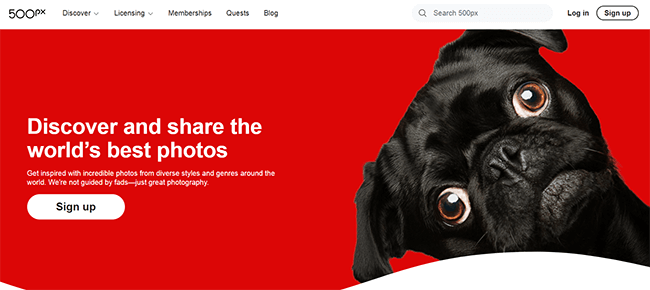
Instead of charging photographers fees on each image sold, they charge a monthly subscription fee which allows creators to enjoy a 100% royalty option. They also offer a free plan, but free plan creators will be charged a 40% commission on any images sold.
500px is all about quality too. Instead of allowing the marketplace to become saturated with sub-par photos, the team at 500px carefully reviews each photo to ensure that they are technically sound and commercially viable.
However, if you’re a skilled photographer, this is almost certainly a positive thing, as customers will find it easier to discover your images, without having to sift through heaps of lower-quality photos first.
So, if you’re willing to invest in a monthly subscription, then 500px is a very good option.
How to sell photos online as prints
Although there is a huge market for selling digital copies of your photos, lots of people also want to buy physical photo prints, and this is one of the best ways to earn some extra cash from your work.
The easiest way to sell prints is to use a print on demand service. With print on demand, you list your products for sale on a marketplace or your own site, and as soon as a customer purchases the product, the POD service prints and ships the product for you.
The POD service then deducts the base cost of the product from the sale price, and the rest of the profit is yours to keep. It’s a super easy business model and it can be very lucrative.
As we mentioned earlier, you can use Sellfy to sell photo prints using POD. However, Sellfy isn’t the only print on demand service available. Below are some of the best POD options specifically for selling photography prints.
Gelato
Best selection of POD products
Gelato is a global print on demand service that is a perfect option for photographers looking to sell their prints online. Gelato integrates easily with websites and can also be used to sell POD products on marketplaces like Etsy.
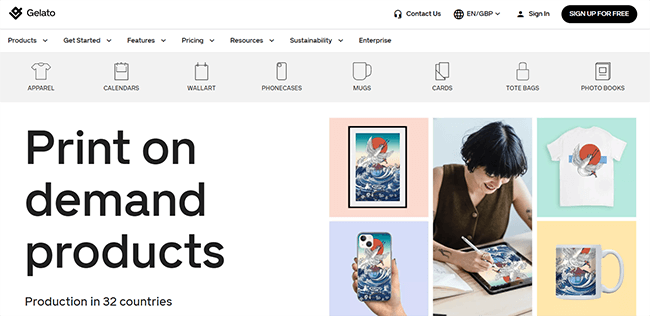
What’s great about Gelato for photographers is that it has a whole section of wall art products for you to choose from. You can sell almost every type of wall hanging you can think of including:
- Wooden framed posters
- Metal framed posters
- Posters with hangers
- Canvases
- Aluminum prints
- Acrylic and foam prints
- Wood prints
With Gelato, you also have the option of selling photo books, calendars and more. If you’re new to POD, then Gelato is a good tool to use as it’s really intuitive and easy to get started with.
Displate
Best for selling premium posters
Displate is a marketplace specifically for selling premium metal posters. These posters are a big hit on social media, so it’s easy to market and sell them.
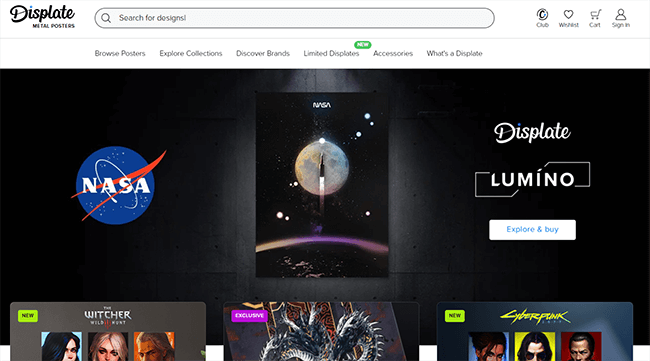
On Displate, customers can use the search function to find your images, or they can explore trending and bestselling poster designs. When they purchase your design, you’ll be paid a commission.
Commission rates on Displate vary, but you can earn up to 50% on each sale if you share your poster designs on social media.
If you specialize in photography styles such as street photography or event photography, then selling your photos on Displate may be a good option.
Redbubble
Best POD marketplace
Redbubble is a well-known artists’ marketplace that is popular among artists, illustrators and photographers, and it’s a great site for selling photo prints.

Redbubble has a huge user base, so it’s a great place to get your work discovered. It also offers a wide range of print-on-demand products, so your customers can enjoy your photos in a variety of formats, from printed mugs and t-shirts to wall art, phone cases, and more.
On Redbubble, customers can search the huge marketplace to find their favorite designs, so you don’t need to worry about having your own website or listing your designs on sites like Etsy.
You also have the option of setting your own artist markup, which is the profit you’ll receive from each sale.
Redbubble is particularly popular with young people and creatives, so if you think your photography style will appeal to this demographic, then it could be the right choice for you.
There’s one final thing I need to mention about Redbubble and that is the fees. For new and low-volume sellers, it works out excessive. Redbubble takes an initial cut on a per-product basis and an account fee. The account fee comes out of your monthly profit and only applies to those on the standard plan.
You can avoid these account fees by getting onto a higher tier plan but they’re invite only and Redbubble isn’t transparent about the selection criteria.
Fine Art America
Best for high-quality prints
Fine Art America is another print on demand marketplace that is most suitable for selling extremely high-quality photographs. With Fine Art America, you can only sell physical products, so it’s not suitable if you want to sell both physical and digital products from the same place.
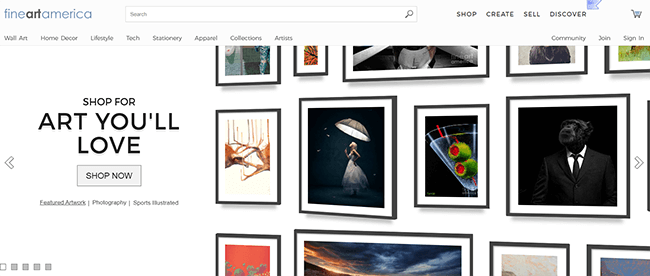
Getting started with Fine Art America is free, and you can choose what product options you want to make available to customers. You can have your photos printed in a range of formats, from canvas to framed prints, and you can set your own preferred markup for each product.
Fine Art America also has global fulfillment centers and a range of sales and marketing tools that can help you to boost your POD sales.
The main perk of Fine Art America is that the prints that they create are extremely high-quality. So if you’re looking for a way to sell your photos as museum-quality prints, this is the option for you.
How to market your photos
If you want to maximize your photo sales, then you’ll need to put a little effort into marketing too. Here are some of our top tips for marketing your photos.
Drives sales through Instagram
Of all the social media platforms, Instagram is the most image-focused, which is why it is the perfect platform for marketing your online photography.
If you want to boost sales, it’s a good idea to share your photographs on Instagram and try and build a following. You can do this by using the right hashtags for your images, posting regularly and at the right times, and engaging with other accounts to try and build a good community.
Once you have a small following, you can add a link to your bio to direct people to your photo listings on your website or on marketplaces.
If you’re sharing photographs that you intend to sell, then be sure to add watermarks to them so that people can’t copy and paste them from Instagram to use them for free.
Make use of SEO
If you plan to sell your photos from your own website then you can make use of search engine optimization to direct web users to your site. You can use tools like SE Ranking to find high-volume keywords to include in your product listings.
Then, when people search for these specific terms on Google, your website will hopefully rank in the results pages. You can also add an SEO blog to your website to help improve your website rankings and drive traffic to your photography ecommerce site.
Market your photos in person
When it comes to selling your photos online, your marketing doesn’t necessarily have to be digital.
For example, if you are photographing a particular event or location, then it’s a good idea to carry business cards with your website details and social media handles printed on them.
That way people who are also attending the event and want to purchase professional photos that you have taken can easily do this online when they return home.
This is also a good tactic if you are a street or fashion photographer that takes photographs of passers-by, as the subjects of the photos may be interested in buying a professional print or digital download of your photo.
Final thoughts
So there you have it—everything you need to know about how to sell stock photos.
Selling digital products like photos is one of the best ways to make money online.
Don’t forget—you don’t have to sell photos specifically. You can use them as a basis to create other products. For example, as physical prints or custom merchandise via platforms like Sellfy and Gelato.
But if you don’t want to sell photos, there are tons of other products you could sell instead.
Check out some of our other how-to guides to explore your options:
- How To Sell Ebooks
- How To Sell Audiobooks
- How To Sell PDFs
- How To Sell Videos
- How To Sell Digital Art
- How To Sell Fonts
Disclosure: Our content is reader-supported. If you click on certain links we may make a commission.
